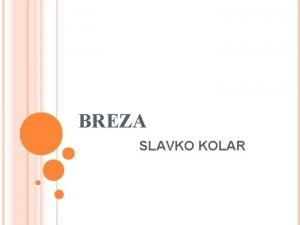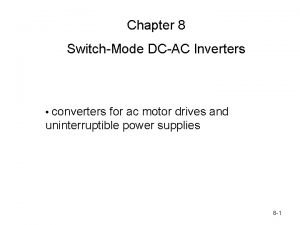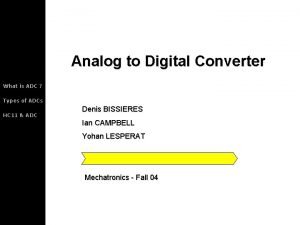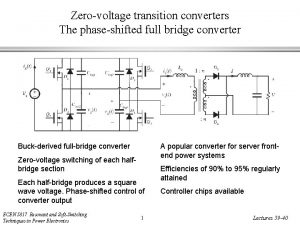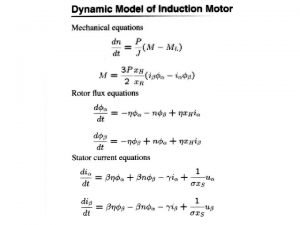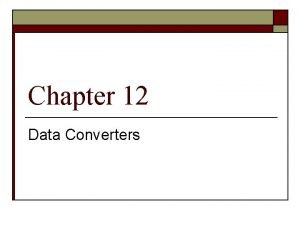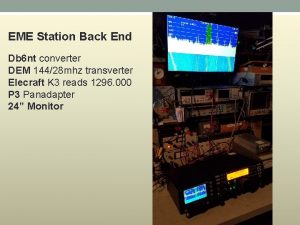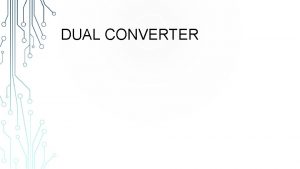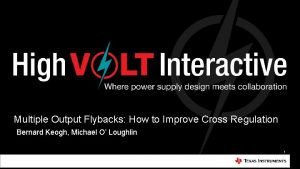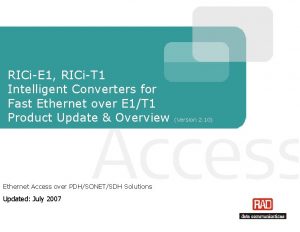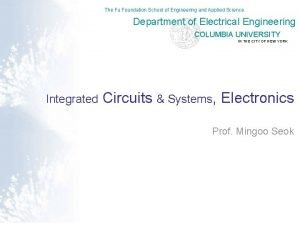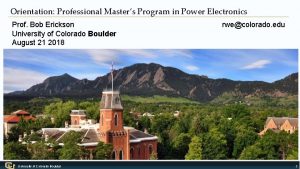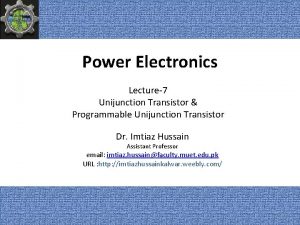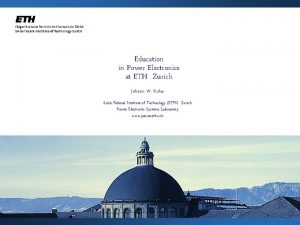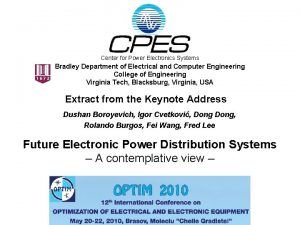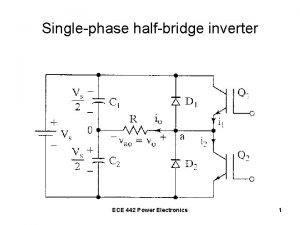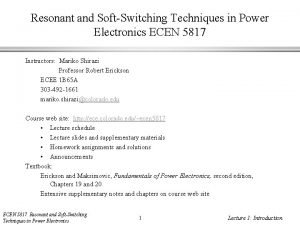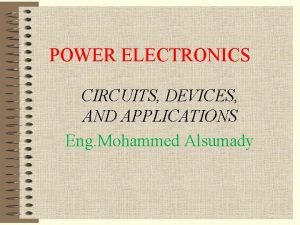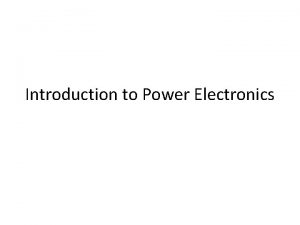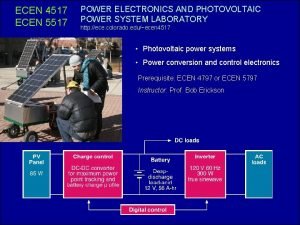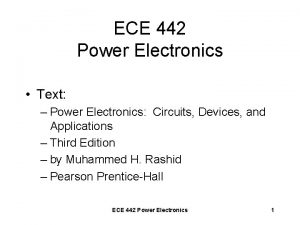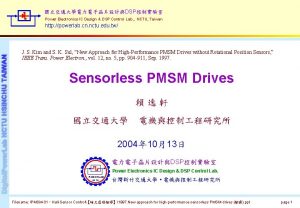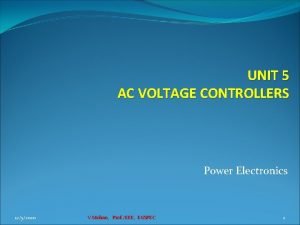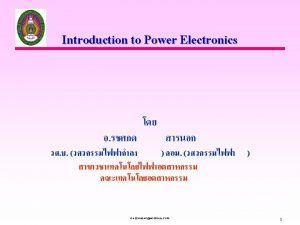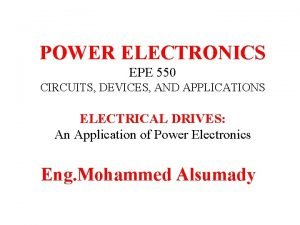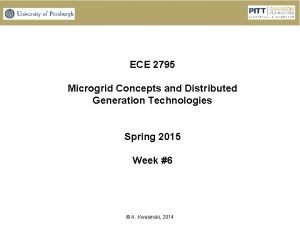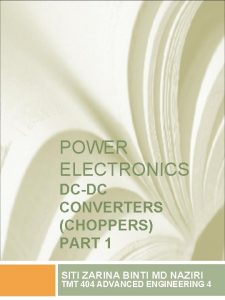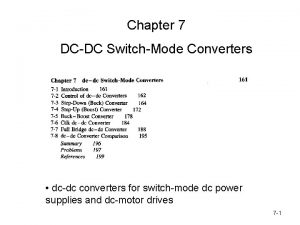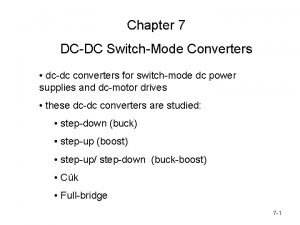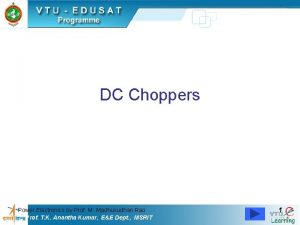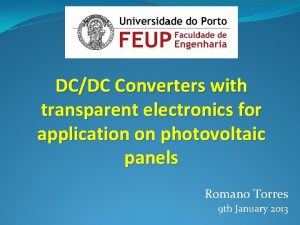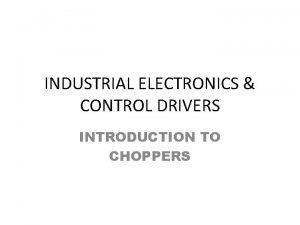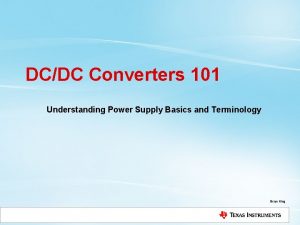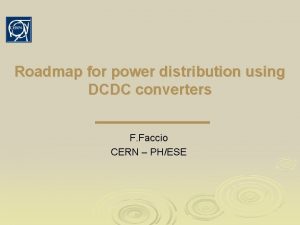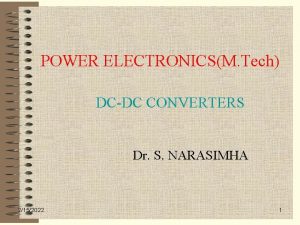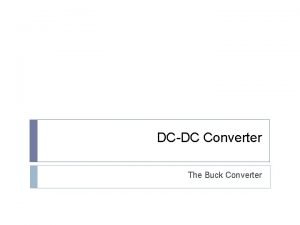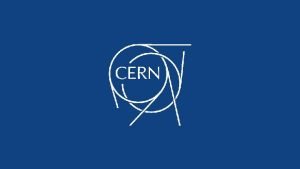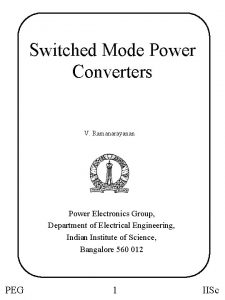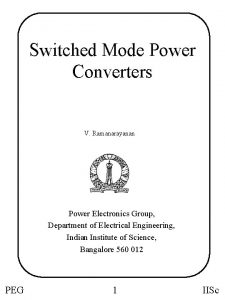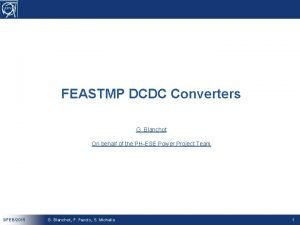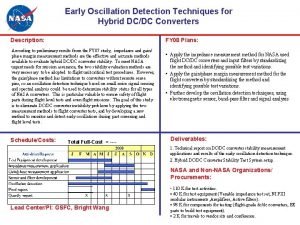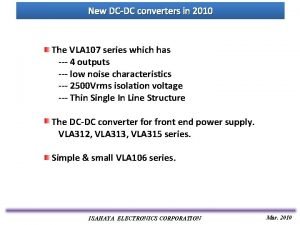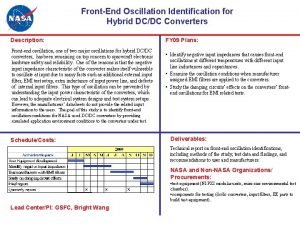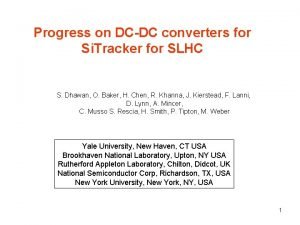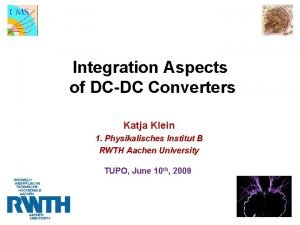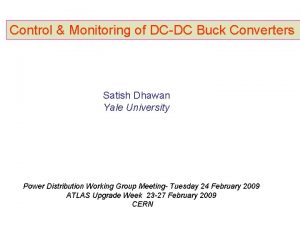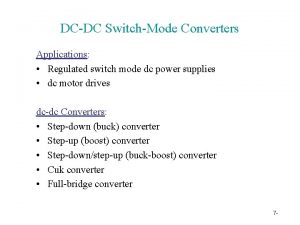POWER ELECTRONICS DCDC CONVERTERS CHOPPERS PART 2 ILI






















![Full-bridge Converter Operation Switch “pair”: [S 1 & S 2]; [S 3 & S Full-bridge Converter Operation Switch “pair”: [S 1 & S 2]; [S 3 & S](https://slidetodoc.com/presentation_image_h/a31d6cf86d48d95116a632cf93268b78/image-23.jpg)












- Slides: 35

POWER ELECTRONICS DC-DC CONVERTERS (CHOPPERS) PART 2 ILI SALWANI MOHAMAD EMT 369

Content Ø Content Switch-mode Power Supply (SMPS) Ø Transformer Models Ø Types of SMPS: § Flyback Converter § Full-bridge Converter § Half-bridge Converter Ø Questions/Discussions Ø Ø (provided in separate sheet) SOURCES: “Power Electronics”, Daniel W. Hart, Mc-Graw Hill, “Power Electronics & Drives”, Lecture Notes, Dr. Zainal Salam, UTM

Switch-mode Power Supply Advantages over linear power Efficient (70 -95%) Weight and size reduction Disadvantages Complex design Electromagnetic interference (EMI) problems However above certain ratings, SMPS is the only feasible choice Types of SMPS Flyback Forward Push-pull Bridge (half and full)

Switch-mode Power Supply Block diagrams Basic Block diagram of linear power supply Basic Block diagram of SMPS

Switch-mode Power Supply Isolated topologies All isolated topologies include a transformer, and thus can produce an output of higher or lower voltage than the input by adjusting the turns ratio. For some topologies, multiple windings can be placed on the transformer to produce multiple output voltages. Some converters use the transformer for energy storage, while others use a separate inductor.

Switch-mode Power Supply Isolated types Source: Wikipedia

Once again…


Transformer Models 2 basic functions: I/O electrical isolation Step-up/step-down time varying voltages & currents I/O relationship of idealized model: Models: Ideal model Model used in most PE circuits

Transformer Models (a) Transformer (b) Ideal Model (c) Complete model (d) Most used for power electronics circuits

Flyback Converter Flyback converter is a buck-boost converter with the inductor split to form a transformer voltage ratio are multiplied with additional advantage of isolation Circuit Equivalent circuit includes magnetizing inductance

Flyback Converter Switch closed Switch open

Assumption for the analys The output capacitor is very large->? The switch and diode are ideal The circuit is operating in the steady s Duty ratio is D, being closed for time D And open for (1 -D)T

Flyback Converter Magnetizing inductance current Source current Diode current Capacitor current Transformer primary voltage

Flyback Converter Switch closed

Flyback Converter Switch open

Flyback Converter Steady-state Operation Note: I/O relationship is similar to buck- boost converter, with the present of transformer ratio Output depends to value of D (greater or less than input)

Flyback Converter Average Inductor Current

Flyback Converter Min & Max Inductor Current For continuous operation, ILm, min = 0

Flyback Converter Output Voltage Ripple Same as buck-boost converter Equivalent series resistance

Example Solution

Full-bridge Converter Circuit D – duty ratio of each switch pair
![Fullbridge Converter Operation Switch pair S 1 S 2 S 3 S Full-bridge Converter Operation Switch “pair”: [S 1 & S 2]; [S 3 & S](https://slidetodoc.com/presentation_image_h/a31d6cf86d48d95116a632cf93268b78/image-23.jpg)
Full-bridge Converter Operation Switch “pair”: [S 1 & S 2]; [S 3 & S 4] Each switch pair turn on at a time as shown. The other pair is off. When [S 1 & S 2] is closed – voltage across transformer primary is Vs When [S 3 & S 4] is closed – voltage across transformer primary is -Vs “AC voltage” is developed across the primary. Then transferred to secondary via high frequency transformers. On secondary side, diode pair is “high frequency full wave rectification”. The choke (L) and (C) acts like the “buck converter” circuit.

Full-bridge Converter Waveforms Switching sequence Voltage on transforme primary Voltage vx


Half-bridge Converter

Half-bridge Converter Waveforms Switching sequence Voltage on transforme primary Voltage vx



Questions/Discussions Flyback Converter The flyback converter has the following parameters: Vs = 36 V, D = 0. 4, N 1/N 2 = 2, R = 20 Ω, Lm = 100 μH, C = 50 μF, and the switching frequency is 100 k. Hz. Determine: the output voltage the maximum and minimum inductor current the output voltage ripple A flyback converter has an input of 44 V, an output of 3 V, a duty ratio of 0. 32, and a switching frequency of 300 k. Hz. The load resistor is 1 Ω. Determine: the transformer turns ratio the transformer magnetizing inductance Lm such the minimum inductor current is 40% of the average.

Buck example 1 A buck converter is supplied from a 50 V battery source. Given L=400 u. H, C=100 u. F, R=20 Ohm, f=20 KHz and D=0. 4. Calculate: (a) output voltage (b) output voltage ri

Buck Example 2

Boost Example 1 The boost converter of Fig. 6 -8 has parameter Vs=20 V, D = 0. 6, R =12. 5Ω L = 10 μH, C = 40 μF, and the switching frequency is (a) (b) (c) (d) Determinethe output voltage. Determine the average, maximum, and minimum ind currents. Determine the output voltage ripple. Determine the average current in the diode. Assume ideal components.

Boost Example 2 A boost converter has an input of 5 V and an output of 25 W at 15 V. The minimum inductor current must be no less than 50% of the average. The output voltage Ripple must be less than 1%. The switching frequency 300 k. Hz. Determine the duty cycle ratio, min inductor v And minimum capacitor value.

Example Buck-Boost 1 Buck-boost has these parameters: Determine : i. Output Voltage = -16 V ii. Inductor current average = 5. 33 A, 4. iii. Inductor current = 7. 33 A, 2. 93 A maximum and minimum values iv. Output voltage ripple = 1%
 Cbi detroit
Cbi detroit Breza tema
Breza tema Dcac converters
Dcac converters What us adc
What us adc Catalytic converter reaction mechanism
Catalytic converter reaction mechanism Dac konverter
Dac konverter Dcac converters
Dcac converters Digital to analog converters basic concepts
Digital to analog converters basic concepts Eme converters
Eme converters 3 phase dual converter
3 phase dual converter Under the hood of flyback smps designs
Under the hood of flyback smps designs Intelligent converters
Intelligent converters Power triangle
Power triangle The fu foundation school
The fu foundation school Ecen 5797
Ecen 5797 Ujt formula
Ujt formula Eth power electronics
Eth power electronics Center for power electronics systems
Center for power electronics systems Ampegon power electronics ag
Ampegon power electronics ag Power electronics
Power electronics Power electronics
Power electronics Power electronics circuits devices and applications
Power electronics circuits devices and applications Introduction to power electronics
Introduction to power electronics Power electronics
Power electronics Ece 442
Ece 442 Dsp in power electronics
Dsp in power electronics Ac regulators in power electronics
Ac regulators in power electronics Power electronics
Power electronics Power electronics
Power electronics Rectifier power electronics
Rectifier power electronics Part whole model subtraction
Part whole model subtraction Unit ratio definition
Unit ratio definition Part part whole
Part part whole What is a technical description?
What is a technical description? Parts of a bar club
Parts of a bar club The part of a shadow surrounding the darkest part
The part of a shadow surrounding the darkest part

